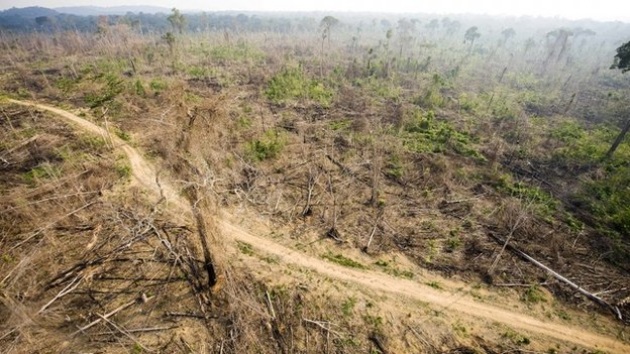La deforestazione del più grande polmone verde della terra
Dal 1991 a oggi la foresta amazzonica ha subito un disboscamento elevato causato dall’espansione delle città, dai grandi e piccoli allevatori e dai produttori di soia. Le poche popolazioni scappate alla colonizzazione del 1500 rischiano piano piano di estinguersi a causa dell’incontrollato disboscamento.
La Foresta Amazzonica è considerata una grossa risorsa per l’allevamento di bestiame e la coltivazione di soia. Una relazione del 2009 di Greenpeace ha scoperto che il settore del bestiame nell’Amazzonia brasiliana, sostenuta dalle produzioni internazionali di carni bovine e cuoio, era responsabile di circa l’80% di tutta la deforestazione nella regione, e circa il 14% della deforestazione annua totale del mondo, diventando così il più grande responsabile della deforestazione al mondo. Secondo un rapporto del 2006 dall’Organizzazione delle Nazioni Unite per l’Alimentazione e l’Agricoltura, il 70% delle terre che in precedenza erano coperte da foreste in Amazzonia, e il 91 % dei terreni disboscati dal 1970, viene utilizzato per il pascolo del bestiame.
Fino al 2006, una delle principali cause di perdita delle foreste in Amazzonia era la coltivazione della soia, principalmente per l’esportazione e la produzione di biodiesel e di mangimi; quando i prezzi di soia aumentavano, gli agricoltori di soia si spingevano verso nord in aree boscose dell’Amazzonia. Tuttavia, accordi di settore privato come la moratoria sulla soia hanno contribuito a ridurre drasticamente la deforestazione legata alla produzione di questo legume nella regione. Nel 2006, una serie d’importanti aziende di commercio di materie prime, come la Cargill, ha accettato di non acquistare semi di soia prodotti nel Brasile sulle aree recentemente deforestate. Prima della moratoria, il 30% dell’espansione dei campi di soia è stato realizzato disboscando aree della foresta, contribuendo a registrare un drastico aumento dei tassi di deforestazione. Dopo otto anni di moratoria, uno studio del 2015 ha rilevato che, sebbene le zone di produzione di soia si fossero estese di altri 1,3 milioni di ettari, solo circa l’1% della nuova espansione era avvenuto a scapito della foresta. Come risposta alla moratoria, gli agricoltori hanno scelto di piantare sui terreni già disboscati in precedenza.
Le esigenze degli agricoltori di soia sono state utilizzate per validare alcuni progetti di trasporto controversi che si sono sviluppati in Amazzonia. Le prime due autostrade, la Belém – Brasilia (1958) e la Cuiaba-Porto Velho (1968), furono le uniche autostrade federali in Amazzonia Legale lastricate e percorribili tutto l’anno prima della fine del 1990. Queste due strade si trovano nell’area focale della deforestazione nell’Amazzonia brasiliana. L’autostrada Belém-Brasilia ha attirato quasi due milioni di coloni nei primi venti anni. Il successo della strada Belém-Brasilia aumentò quando le strade asfaltate continuarono a svilupparsi, scatenando un’irrefrenabile diffusione dell’insediamento. I completamenti delle strade furono seguiti da un’ondata di reinsediamento; i coloni ebbero un effetto significativo sulla foresta.
Una ricerca condotta da Leydimere Oliveira et al. ha dimostrato che più foresta pluviale viene disboscata in Amazzonia, meno precipitazioni raggiungono la zona e quindi minore diventa la resa per ettaro. Così per il Brasile nel suo complesso, non vi è alcun guadagno economico da effettuare deforestando, vendendo gli alberi e utilizzando i terreni disboscati per fini pastorali. Nel 2009, il presidente peruviano Alan García, favorì il decreto legge 840 (anche conosciuto come “Ley de la Selva”, “la legge della giungla” o semplicemente la “Forest Law”), che ha permesso la vendita di terreni incolti dell’Amazzonia di proprietà statale a società private, senza limiti di termine sui diritti di proprietà. Mentre la legge è stata promossa come misura per la “riforestazione”, i critici hanno sostenuto che il provvedimento di privatizzazione in realtà non fa altro che provocare un’ulteriore deforestazione dell’Amazzonia, cedendo i diritti della nazione sulle risorse naturali agli investitori stranieri e lasciando incerto il destino dei popoli indigeni del Perù, che in genere non hanno nessun titolo formale sulle foreste su cui sussistono. La legge 840 ha incontrato una diffusa resistenza e fu alla fine abrogata dal legislatore del Perù perché incostituzionale.
Nel mese di settembre 2015, il presidente brasiliano Dilma Rousseff ha comunicato alle Nazioni Unite che il Brasile ha effettivamente ridotto il tasso di deforestazione in Amazzonia dell’82%. Ha anche annunciato che nei prossimi 15 anni, il suo Paese mira ad eliminare la deforestazione illegale, a ripristinare e rimboschire 120.000 km² (46.000 sq mi) di terreno e a recuperare 150.000 km² (58,000 sq mi) dei pascoli degradati.
Location
South America, Amazon Rainforest
Environmental impact
- Biodiversity loss – Ecosystem destruction
- Depletion of natural resources (fossil and mineral, forest, water, etc)
- Alteration of landscape aesthetics and built heritage
Ethical/ legal issues
- Health and well-being
- A clean and prosperous environment and a safe and pleasant habitat
- Access to public goods/ resources and products
Information sources & materials
Online books and newspaper, magazine, encyclopedia, or blog articles
Foresta amazzonica altervista: http://forestaamazzonica.altervista.org/
Amazzonia Greenpeace: http://www.greenpeace.org/italy/it/campagne/foreste/amazzonia/
Contributor(s)
- Sasha Ricci
- Federico Rosatelli



Home › Forums › The deforestation of the largest green lung of the Earth